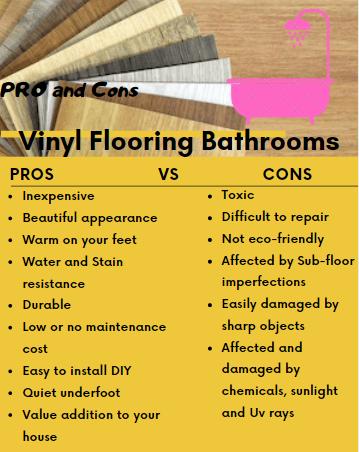Understand what makes vinyl such a viable flooring option—as well as the downsides to this popular product—to decide whether to install it or remove it from your home.
ByAndréanaLefton andBobVila | Updated Sep 24, 2020 5:37 PM
Photo: homedepot.com via Armstrong
Vinyl is the most popular form of resilient flooring (a category that also includes linoleum and cork) because it’s low-maintenance, water-resistant, cost-effective, and long-lasting. It also has the perfect balance of firmness and “give,” meaning it springs a bit when you walk on it for a comfortable feel underfoot. And thanks to recent technological advances, today’s vinyl comes in a wide range of high-quality, beautiful finishes.
But vinyl flooring does have its downsides. So whether you’re considering installing vinyl or wondering what it takes to remove an existing vinyl floor, read on. We’ve laid out key vinyl flooring pros and cons—from installation and removal—so you can make the right decision for your home.
Photo: istockphoto.com
PRO: Vinyl floors are relatively easy to install.
Developments in the vinyl flooring industry have made the product more DIY friendly. While vinyl was once only available in large, unwieldy sheets, today’s tiles and planks are much easier to install with no sawing or hammering. Most luxury brands now offer “self-adhesive” vinyl—simply remove the backing and press into place on a properly prepared subfloor.

Here’s a general idea of how to install vinyl plank flooring:
CON: Vinyl floors can be tough to remove.
Once vinyl’s adhesive backing hardens to the floorboards, the glue is difficult to remove. Fortunately, removing vinyl floors doesn’t require professional tools or techniques; it’s all about elbow grease.
Consult a flooring expertFind licensed flooring experts in your area and get free, no-commitment estimates for your project. Find local pros+Photo: homedepot.com via Home Decorators Collection
PRO: Vinyl floors are affordable.
At between $2 and $5 per square foot, including installation, luxury vinyl flooring is a bargain compared to wood floors, which can cost $10 per square foot, and carpeting, at $3 to $5.50 per square foot. The savings continue when you factor in that vinyl is cheaper to clean and maintain than other types of flooring. If you’re really on a tight budget, note that sheet vinyl is the most economical option.
CON: Vinyl can be of inconsistent quality.
Despite the expansive category of “luxury vinyl,” quality varies, even among such top-rated brands as Shaw, Armstrong, Mannington, Lumber Liquidators, and Karndean. Focus on thickness and construction to determine quality.
AdvertisementPhoto: homedepot.com via IVC
PRO: Vinyl floors can be beautiful and unique.
You may be surprised by the striking, unusual patterns and textures you can get with vinyl flooring today. Among the convincing wood-like finishes are distressed and hand-scraped versions. You’ll find a variety of stone and marble effects (slate and travertine are hot trends for 2019), as well as “groutable” vinyl tiles that are laid and grouted like their ceramic counterparts.
CON: Older vinyl floors were made with asbestos.
If the vinyl in your home was produced during the 1980s or earlier, it very likely included asbestos—which has been linked to a number of serious diseases, including cancer. If your floors are in good condition (e.g., no cracks or scoring to the surface), the asbestos is probably not being released and you need not worry about health risks. However, if you’re considering removing and replacing an old vinyl floor, or just want to determine if asbestos is present in your home, you can buy an at-home asbestos testing kit or hire a professional to test it. If asbestos is found, you must have a professional remove the toxic flooring; do not under any circumstances tear it up yourself.
Photo: istockphoto.com
PRO: Vinyl floors are highly durable—when cared for properly.
Yes, vinyl is rugged, but you must maintain it correctly to retain its good looks. To prevent damage, use rugs or mats in heavily trafficked areas, and put coasters or protective felt tips on the base of furniture legs. When moving furniture, employ sliders or a sheet of plywood.
To clean vinyl, steer clear of abrasive scrubs, scouring pads, detergents, waxes, solvents, and ammonia—all agents that can dull and damage the surface. Instead, dry mop or vacuum to remove surface dust and dirt (avoid the “beater bar” vacuum attachment). Deep clean with a homemade solution of one cup of white vinegar mixed with a gallon of hot water, adding a few drops of mineral oil to amp shine, if desired. If using a commercial cleaner, be sure it’s designed for vinyl floors.
Consult a flooring expertFind licensed flooring experts in your area and get free, no-commitment estimates for your project. Find local pros+Disclosure: BobVila.com participates in the Amazon Services LLC Associates Program, an affiliate advertising program designed to provide a means for publishers to earn fees by linking to Amazon.com and affiliated sites.
TAGS: CHOOSE FLOORING VINYL